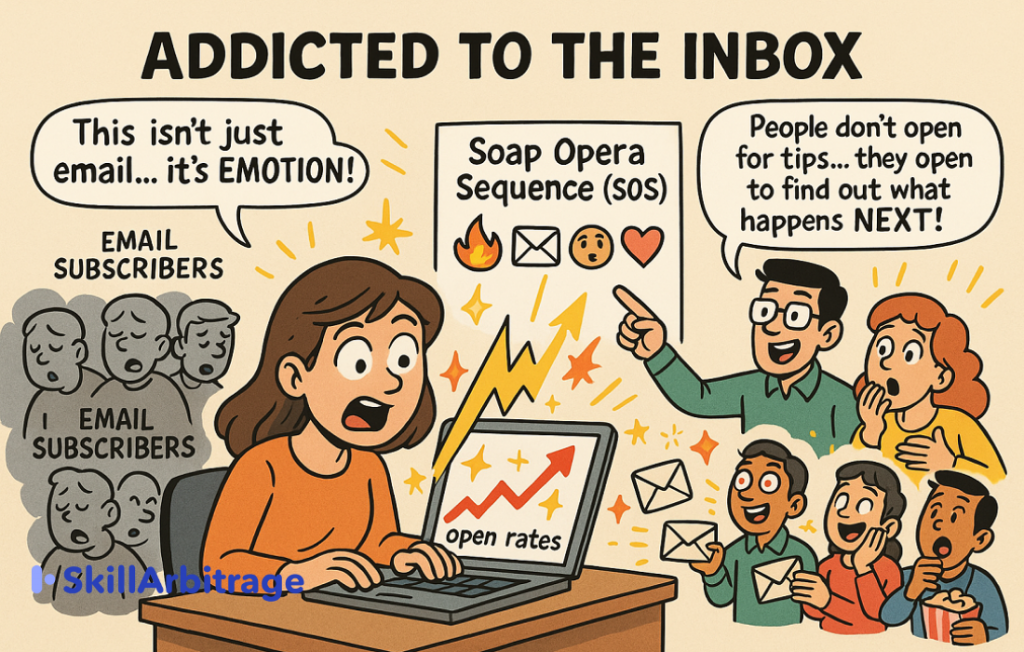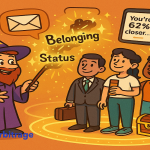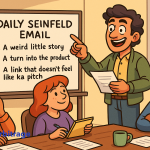This article explains how Russell Brunson’s Soap Opera Sequence works and why it helps build a stronger connection with new subscribers. It breaks down the 5-part structure and shows how each email is designed to create curiosity, introduce a personal story, and guide the reader toward a specific action.
Table of Contents
Previously on Attractive Character…
Parvathishankar broke down the Attractive Character framework for Harsh, showing him how founders can turn personality into persuasion by sharing flaws, backstory, and mission. This gave Harsh a clear structure for helping clients feel more relatable and trusted.
In this article, Harsh explains to Swathi, who needs a high-retention welcome sequence for Tantra, how the Soap Opera Sequence uses emotional hooks and open loops to keep readers glued to each email, turning curiosity into connection.
(Continued…)
For over a week, Swathi had been watching her email list rot.
She’d worked hard to get those subscribers. QR codes on perfume bottles. Lead magnets on the website. Shoutouts on influencer stories. But every time she checked the numbers, the pattern stayed the same: open rates plummeted after the first email. Replies? Zero.
It bothered her more than she admitted. Not because of the numbers, but because of what it meant. These people had shown interest. They’d chosen Tantra. Then they’d left. Not with a bang. Just… faded out.
She rewrote the welcome emails three times. Shorter. Longer. More brand story. Less. She even tried a giveaway in the second email. Nothing worked.
By Thursday, she couldn’t take it anymore.
She cornered Raja, Savitha, and Harsh at the Tantra office. The three of them were camped in their usual war room, tossing ideas for another campaign. Swathi walked in, shut the laptop, and dropped hers in the center.
“Look at this. People are ghosting me,” she said. “I’m not even asking them to buy. Just read. Stay. Something. But it’s like they lose interest after email one.”
Harsh leaned forward, scanning the numbers. “That’s not drop-off,” he said. “That’s story failure.”
Swathi stared. “What?”
“You’re not giving them a reason to care. Or come back. There’s no arc. No tension. No cliffhanger.”
Savitha tilted her head. “You’re saying she needs drama?”
Harsh smiled. “She needs the Soap Opera Sequence.”
Swathi blinked.
Harsh nodded. “You don’t have a welcome sequence. You have a digital pamphlet. And bored people don’t stick around. But if we build a sequence that creates emotional whiplash, like a soap opera, they’ll not only open every email, they’ll wait for them.”
Finally, someone had handed her the cold bottle of water she’d been craving all week.
Soap Opera Sequence (SOS)
Swathi folded her arms. “Soap Opera Sequence sounds like something Adityan would come up with to sell mascara.”
Harsh grinned. “Trust me, it’s smarter than it sounds. It’s a structure Brunson stole from actual TV soap operas. Five emails. Each one designed to create tension, deepen the emotional hook, and end with an open loop.”
Raja leaned back, amused. “So, basically, K-serials for inboxes.”
“Exactly,” Harsh said. “Except instead of ‘Will Priya find out about the second marriage?’ it’s ‘Will Tantra finally crack what makes a perfume unforgettable?’”
Core idea
Harsh didn’t pause. “Most onboarding emails are forgettable. Generic welcome note. Link to a lead magnet. A pitch or two. People stop opening by day three.”
Swathi said, “And this changes that?”
“Yes. It works like a daily soap. You hook people with an ongoing story, not a one-time message. You stretch tension across emails.”
Raja raised an eyebrow. “So instead of delivering value, you delay it?”
Harsh shook his head. “You deliver emotional value. You build a character they care about. Show them the stakes. Make every email feel like it ends mid-sentence.”
Swathi leaned forward. “Who came up with this?”
“Andre Chaperon. He pioneered serialized email storytelling. Brunson took it mainstream with a 5-email version called the Soap Opera Sequence.”
Savitha said, “So you turn your welcome sequence into a mini-series.”
Harsh nodded. “Exactly. A personal, high-stakes drama. With your brand at the center.”
Why it works
Swathi looked skeptical. “But why does this work? Isn’t it just gimmicky drama?”
Harsh shook his head. “It works because it mirrors how people actually get addicted to stories. Small doses. Daily. Emotional payoff just out of reach.”
Raja nodded. “Same reason people binge-watch shows they claim to hate.”
Harsh continued. “It’s not about tricks. It’s about tension. People don’t open emails for tips. They open to find out what happens next.”
Savitha said, “And the Attractive Character keeps them emotionally involved.”
“Exactly,” Harsh said. “It’s not a lecture. It’s a person they root for. If you build that connection, you don’t need hard sells. The offer just feels like the next step in the story.”
Swathi leaned back. “So it’s not just content. It’s a relationship.”
“Right,” Harsh said. “And you build it one unresolved loop at a time.”
5 email sequence
Email #1: Set the stage
Purpose: Welcome. Set expectations. Begin the story.
Swathi leaned back in her chair. “So the first email is the welcome. What exactly do we say?”
Harsh grinned. “You thank them for subscribing, of course. You also introduce the Attractive Character, whether it’s you or your brand. And most importantly, you tease that something big is coming tomorrow. Set the tone. Let them know this isn’t just another boring email series.”
Raja nodded. “It’s like opening the first page of a book. You want to make them feel, ‘I need to know what happens next.’”
“Exactly,” Harsh said. “The hook could be something like, ‘I’m going to give you my best product for free but only if you open tomorrow’s email.’”
Email #2: Open with high drama
Purpose: Grab attention. Start mid-crisis, not from the beginning.
Savitha leaned forward. “So no slow intros?”
Harsh shook his head. “No. You drop them right into the drama. Start in the middle of a turning point, like you’re at the peak of the crisis. Then, rewind. Tell them how you got there.”
Raja smirked. “So instead of, ‘I started my business in 2010,’ it’s more like, ‘The day I almost gave up on Tantra…’?”
Harsh nodded. “Exactly. You tease a solution coming tomorrow, but don’t give it away yet.”
Email #3: Epiphany
Purpose: Reveal your “aha” moment. How everything changed.
Swathi looked up. “And then in email three, I reveal my breakthrough, right?”
Harsh smiled. “Yes, this is where you reveal your epiphany. The ‘aha’ moment when everything clicks. This is where everything changed for you. But you want to tie it emotionally to the offer you’re going to present later. It’s where you first hint at the solution without being salesy.”
Raja added, “Think of it as the turning point. Something like, ‘I realized that what Tantra needed wasn’t just the right scent. It needed a deeper story.’”
Email #4: Hidden benefits
Purpose: Reveal unexpected side benefits from your solution.
Savitha raised her eyebrows. “So here, we go beyond the obvious?”
“Exactly,” Harsh said. “This email is about revealing the unexpected wins you got from your solution. It’s not just about the immediate benefit. You want to show how it changed your life in surprising ways, things they didn’t expect but could relate to.”
Swathi thought for a moment. “Like how Tantra changed the way I see myself?”
Harsh nodded. “Exactly. Those hidden benefits add a human touch and make the story more relatable.”
Email #5: Urgency + CTA
Purpose: Wrap the arc. Drive action with time sensitivity.
Raja leaned forward. “This is the big push, right?”
Harsh grinned. “Yes. The final email. You recap the journey, reopen the loops you created in earlier emails, and close them. This is where you present your offer. Make the ask. But more importantly, you create urgency. Think deadlines, limited bonuses, or something time-sensitive to drive action.”
Savitha nodded. “So this is where we seal the deal?”
“Exactly,” Harsh said. “This is where all the emotional tension and the open loops you’ve created come together and drive people to take action now.”
Turning SOS into a high-value freelancer offering
After Harsh laid out the power of the SOS framework, Raja leaned in, clearly thinking about how this could be turned into a big offer for their clients. Savitha, too, was intrigued. She had seen the potential for Tantra, but this was something bigger. This wasn’t just about sending a few emails; it was about creating relationships.
“Hold up,” Raja said, his tone sharp. “This isn’t just about crafting emails, right? We’re talking about crafting relationships. The kind that pull people in and keep them coming back.”
Harsh nodded. “Exactly. You’re not just a copywriter anymore. You’re a relationship architect. And that’s a premium service.”
Sell relationship-building
Savitha raised an eyebrow. “So how do you turn this into a high-ticket freelance offering? I’m guessing it’s not just about writing five emails.”
Harsh grinned. “You’re right. Here’s the deal: You position this as a strategic solution. You sell the outcome—long-term engagement, loyalty, and a proven system to build trust over time. It’s more than just email writing; it’s about understanding your client’s brand and guiding them through an emotional journey.”
Raja was already pulling out his phone to take notes. “So, we sell the story, not just the content?”
“Exactly,” Harsh said. “Start by offering your clients more than just a one-off service. Show them how the SOS can create a long-term bond with their audience. They’re not just buying emails; they’re buying ongoing engagement. And that’s something they’ll gladly pay for.”
Focus on outcomes
“Alright,” Savitha said, leaning back in her chair, “but how do you actually sell it?”
“Here’s where it gets interesting,” Harsh continued. “Instead of charging by the hour or for each email, you sell the value. You charge for outcomes, not time spent. Clients will pay for the relationship-building aspect. That’s why it’s better as a package rather than a one-off job.”
“Package? So, like, five emails and a few follow-ups?” Raja asked.
“Exactly,” Harsh replied. “But don’t just stop there. Customize the story for each client. If you’re working with a SaaS, maybe you emphasize problem-solving. If it’s a luxury brand like Tantra, make it aspirational. The key is to adapt the story to their specific needs.”
Customize the story
Savitha nodded, getting the idea. “So, instead of ‘I’ll write 5 emails,’ I say, ‘I’ll build your relationship with your customers through a strategic, emotionally-driven sequence that hooks them into your brand.’”
“Yes!” Harsh said. “And once you’ve created the sequence, you can offer ongoing services: updates, optimizations, and new storylines. Make it a retainer model. Once the initial sequence is in place, you’ll be there, guiding them through the ongoing relationship with their audience.”
Swathi raised her eyebrow and crossed her arms. “Okay, you two need to stop hijacking my subscriber problem to plan your next freelance heist.”
Raja grinned. “Hey, knowledge is free. Application is chargeable.”
Savitha laughed. “She’s right, though. We started with Tantra’s welcome sequence and ended up building Harsh a new product.”
Harsh held up his hands. “Guilty. But look, if Tantra nails this, you won’t just reduce churn. You’ll turn new subscribers into fans who wait for your emails.”
Swathi shook her head, smiling despite herself. “Fine. But first, we fix my list. Then you can go build your SOS empire.”
Raja saluted. “Deal. Operation K-Serial Begins.”
Everyone laughed. Even Swathi.
The plan was clear. The story had begun.







 Allow notifications
Allow notifications
